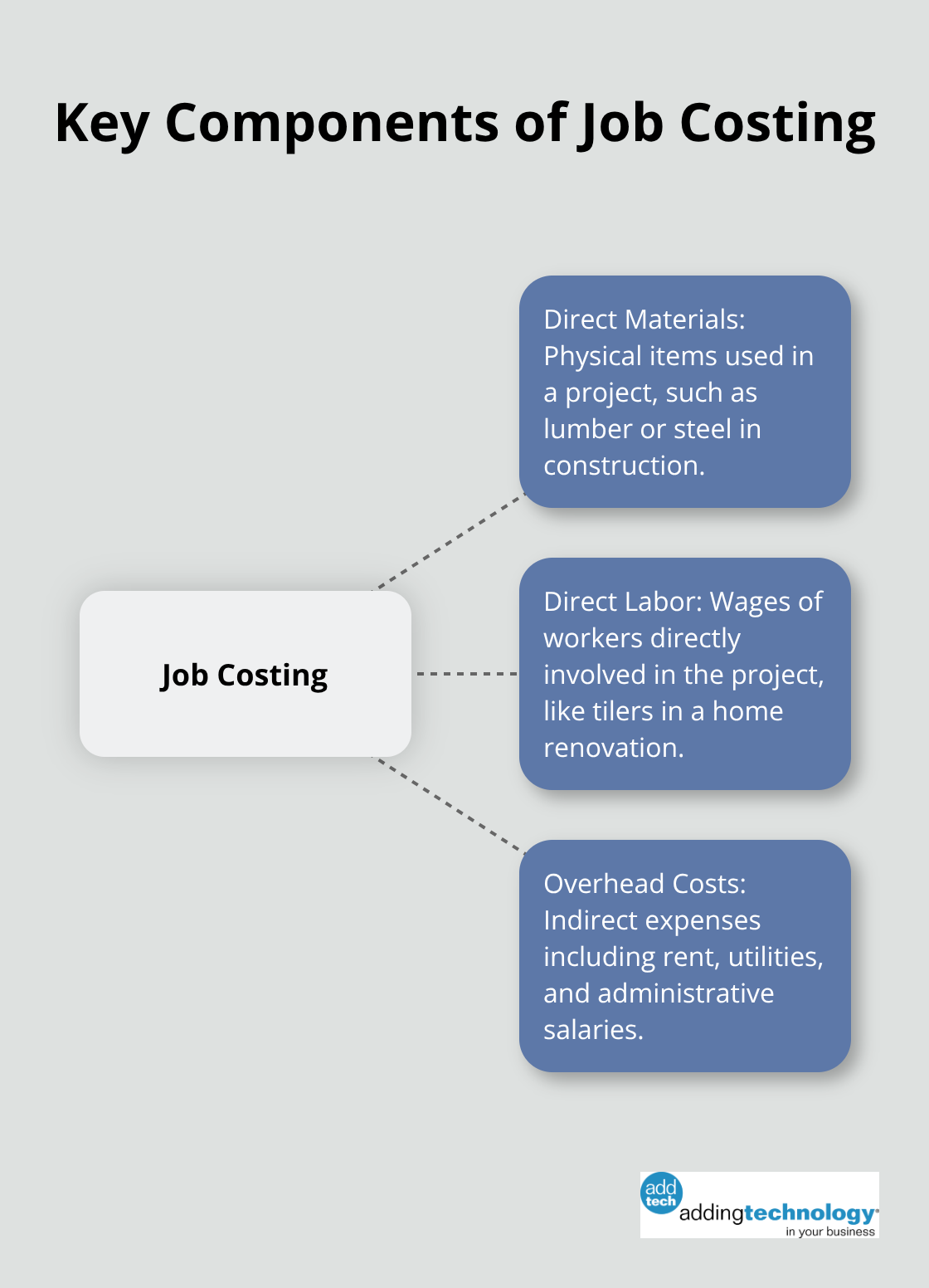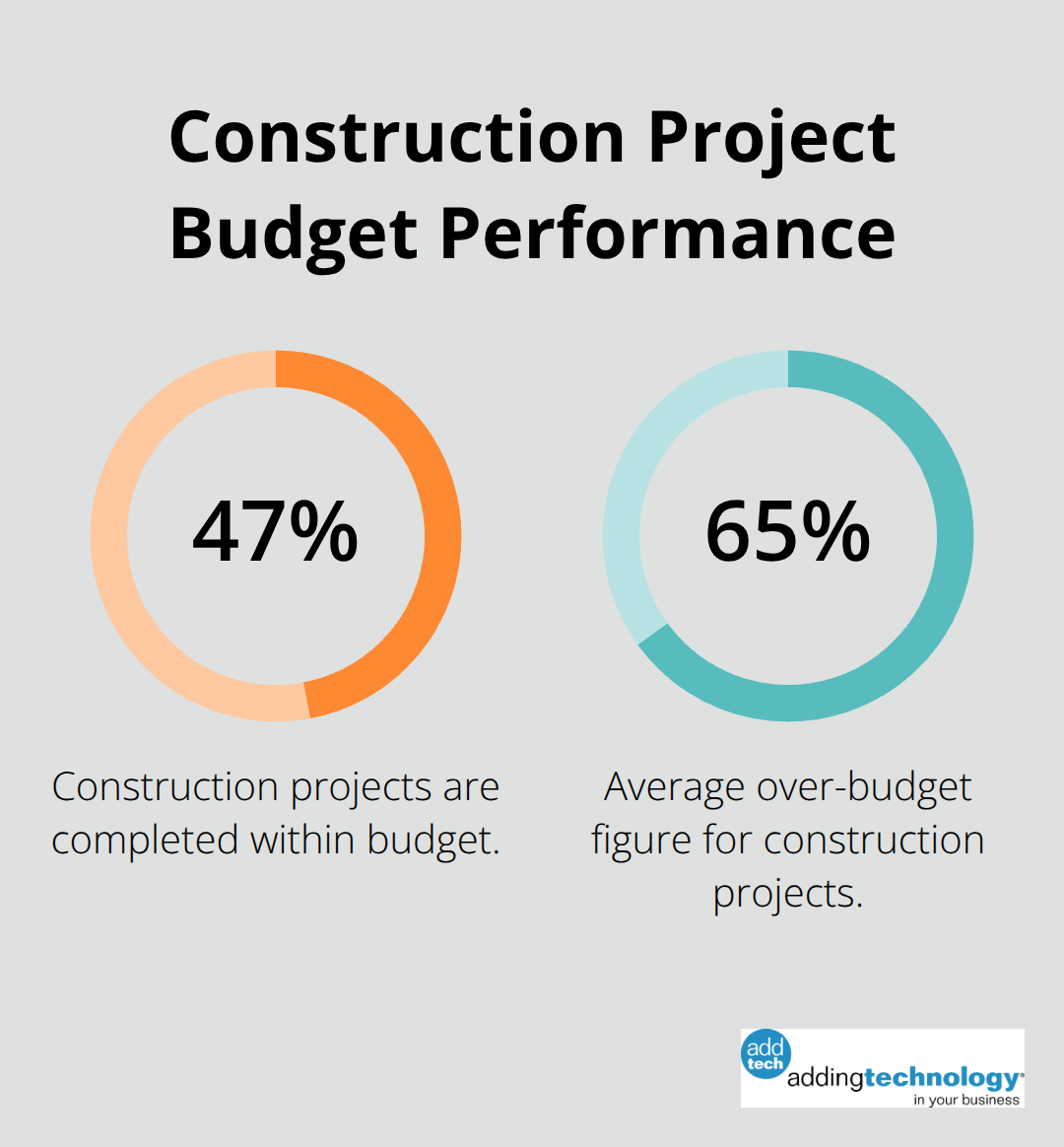
Job costing is a powerful tool for businesses to track and manage project-specific expenses. At adding technology, we’ve seen how this method can transform financial management for companies across various industries.
In this post, we’ll guide you through implementing job costing in your company, with practical examples from construction, manufacturing, and service-based businesses. We’ll cover everything from setting up a system to best practices for maximizing its benefits.
Job costing is a method to track and allocate costs to specific projects or jobs. This approach can transform financial management for businesses, especially in industries like construction.
Job costing involves three main components:

For instance, in a home renovation project:
Job costing can significantly improve your business’s financial health. When a construction company does their job costing the most efficient way, people record expenses daily. Each job needs to have the costs attributed correctly.
Job costing allows you to:
While valuable across many sectors, job costing is particularly important in project-based industries:
In the construction industry, job costing is not just beneficial-it’s essential. Its benefits extend from accurate cost estimation to improved cost control, resource optimization and client trust.
To implement job costing effectively, you need a robust system for tracking and allocating costs. This could range from a simple spreadsheet (for small businesses) to a specialized software solution (for larger operations). The key is to capture and allocate all costs correctly to each job.
Now that we understand the basics of job costing, let’s explore how to set up an effective job costing system in your company.
The first step in setting up a job costing system is to select appropriate software. Small businesses might start with a simple spreadsheet. As your company expands, you’ll need more advanced tools. Construction-specific accounting software offers comprehensive job costing features. These tools integrate with other business processes, provide real-time data, and reduce manual entry errors.
Clear definition of cost categories is essential. Start with the three main categories: direct materials, direct labor, and overhead. Then, break these down further. For example:

A detailed cost categorization system can lead to significant improvements in project profitability. It allows you to identify and reduce wastage in specific material categories.
A logical job numbering system helps track projects efficiently. Consider a system that includes the year, project type, and sequential number. For instance, 23-RES-001 could represent the first residential project of 2023. This system allows for quick identification and sorting of projects.
Your job costing system’s effectiveness depends on the people using it. Invest time in training your staff (including project managers, site supervisors, and accounting personnel). Everyone should understand how to accurately record time, materials used, and other project-related expenses.
Lack of training can result in misinterpretation of data entry requirements, affecting the accuracy of your job costing system.
Setting up a job costing system is not a one-time task. It requires ongoing refinement based on your company’s evolving needs and industry trends. Regular reviews and updates will ensure your system remains effective and continues to provide valuable insights for your business decisions.
The next step in mastering job costing is to understand and implement best practices that will maximize the benefits of your newly established system.
Accurate time tracking forms the foundation of effective job costing. We recommend the implementation of a digital time tracking system that enables employees to log their hours in real-time. This approach minimizes errors and provides a clear picture of labor costs for each project.
Inaccurate time tracking has a direct impact on payroll costs. When hours are miscalculated, construction businesses can end up overpaying. These improvements directly translate to more precise job costing and better profitability.
Don’t wait until a project ends to review your costs. Regular analysis (ideally weekly or bi-weekly) allows you to catch discrepancies early and make necessary adjustments. This proactive approach can prevent cost overruns and keep your projects on budget.
Only 47.9% of construction projects are completed within budget. The average over-budget figure is a whopping 65%!

Your job costing system should not exist in isolation. Integrate it with your other financial processes, such as accounts payable, payroll, and general ledger. This integration ensures that all financial data remains consistent across your organization and provides a holistic view of your company’s financial health.
Many construction companies see a reduction in data entry errors and an increase in financial reporting speed after integrating their job costing with other financial systems.
One of the most valuable outcomes of effective job costing is the wealth of data it provides for future project estimates. Use historical job cost data to refine your estimating process. This approach leads to more accurate bids and helps you avoid underpricing or overpricing your services.
Construction companies that consistently use historical job cost data for estimating report an improvement in bid accuracy.
Job costing is not a set-it-and-forget-it process. Try to regularly assess your job costing system’s effectiveness and make improvements as needed. This ongoing refinement will help you adapt to changing business needs and industry trends, ensuring your job costing system remains a powerful tool for financial success and business growth.
Job costing transforms financial management and project profitability for companies across industries. We’ve explored essential components, from system setup to best practices, highlighting benefits like accurate pricing and data-driven decision-making. Common challenges include resistance to change and setup complexities, but proper planning and training can overcome these obstacles.
Job costing company examples span various sectors, demonstrating its versatility and value. Construction firms manage multiple projects, manufacturing companies price custom orders, and service-based businesses ensure billing precision. These success stories underscore the wide-ranging applications of effective job costing systems.
We at Adding Technology have seen how job costing enhances operational efficiency and financial health, particularly in construction. Don’t let initial hurdles deter you from harnessing its power. Start today (even if small) and watch your company thrive in a competitive market.









At adding technology, we know you want to focus on what you do best as a contractor. In order to do that, you need a proactive back office crew who has financial expertise in your industry.
The problem is that managing and understanding key financial compliance details for your business is a distraction when you want to spend your time focused on building your business (and our collective future).
We understand that there is an art to what contractors do, and financial worries can disrupt the creative process and quality of work. We know that many contractors struggle with messy books, lack of realtime financial visibility, and the stress of compliance issues. These challenges can lead to frustration, overwhelm, and fear that distracts from their core business.
That's where we come in. We're not just accountants; we're part of your crew. We renovate your books, implement cutting-edge technology, and provide you with the real-time job costing and financial insights you need to make informed decisions. Our services are designed to give you peace of mind, allowing you to focus on what you do best - creating and building.
Here’s how we do it:
Schedule a conversation today, and in the meantime, download the Contractor’s Blueprint for Financial Success: A Step by-Step Guide to Maximizing Profits in Construction.” So you can stop worrying about accounting, technology, and compliance details and be free to hammer out success in the field.